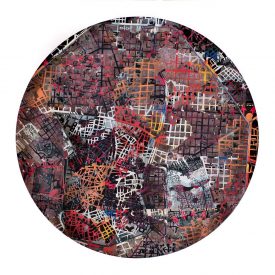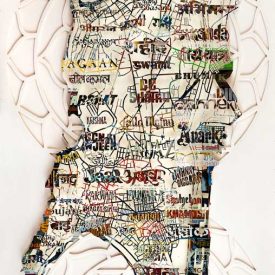The sculpture of Venice contains imagery from Fellini’s film Casanova, the surface street network has been cut from two posters created for the film. The map used in the sculpture is an antique map from the 19th century.
Casanova, born in 1725 is mainly known in history for his sexual conquests, his prowess as a seducer of women and for the many complex affairs he had. He was, however a person with a vast array of other talents, capabilities and achievements. A gifted writer and intellectual who provided one of the best social chronicles of the times, the multi volumed “Histoire de ma vie”, he was also a gambler, a dandy, a preacher, a spy an alchemist and an adventurer who roamed across Europe. During his life, in it’s rise and fall he came to mirror the opulence and decline of the golden age of Venice. The Venice of the time was known as being the pleasure capital of Europe, however by the end of his life, at the close of the century the republic of Venice had fallen to Napoleon.
Fellini’s film is created on an artificial stage set of Venice, which creates a surreal landscape in which he depicts a phantasmagoric carnivalesque world and it is with the famed carnival and masked ball that the film starts. In the midst of this set, Casanova, on the one hand an intellectual figure of the enlightenment is also a mirror of the corrupted decadence of Venetian society that was about to be swept away by Napoleon. In the words of Graham Green Fellini’s film depicts Casanova “with the underlining concept of unrequited love and the notion of sex and death, sex as loneliness and the ultimate downfall of a man who’d built his entire reputation on lust and virility slowly brought down by the ravages of old age and the scorn of a younger generation” The world of the aristocracy is pictured with sumptuous finery and extravagance of costume, and is elaborately and stunningly created in Fellini’s film. Contrasted with this is the squalid, rabelsian depictions of the mass of humanity, a view that shares a kinship with the grotesque and often brutal visions of Breughal.

















